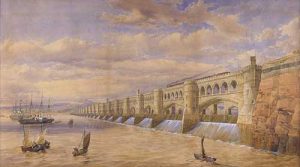
Thomas Fulljames’ watercolour of his plan for a Severn Barrage, ca. 1849. Source: Wikimedia Commons
In recent decades the interest in renewable energy from sources such as wind, solar and tidal power has steadily increased. However, this interest in harnessing “mother nature’s” energy is not new. Over the past 160 years the Severn estuary has been the focus of numerous proposals to provide a transport route over the estuary, improve navigation and to exploit its large tidal range to generate electricity. As a potential source of predictable, renewable and carbon-free power with the potential to supply up to 5 per cent of current UK electricity needs, such interest is understandable. Despite its potential, the latest proposals, like all its predecessors in the past century and a half, have failed to secure government and public support to build a barrage in the Severn estuary.
How is it that a barrage still has not gone beyond the drawing board? And why are companies, scientists and politicians still willing to invest time, effort and money in further proposals? Alexander Portch, a PhD candidate in the Department of History at Bristol University, investigates these two questions. Although the past 150 years is the main focus, Alexander also investigates earlier efforts to harness tidal power of the Severn and how the activities of people whose lives were bound up with the estuary’s daily tides have shaped the estuary and lands bordering it. This episode of the podcast features an interview with Alexander Portch and his work on the history of the Severn Estuary.
Further reading and resources
Blog posts by Alexander Portch on the Power and the Water website.
“Severn Barrage Tidal Power”, The Renewable Energy Website
The Severn Bore website
Charlier, R.H., Menanteau, L., ‘The Saga of Tide Mills,’ Renewable and Sustainable Energy Reviews, 1:3 (1997), 171 – 207.
Godbold, S., Turner, R.C., Hillam, J., Johnson, S., O’Sullivan, A., ‘Medieval Fishtraps in the Severn Estuary,’ Medieval Archaeology, 38:1 (1994), 19 – 54.
Video showing example of tidal mill: Craftsmen: The Tide Miller, 1951 Woodbridge, Suffolk.
Music Credits
“Stockholm” by timberman, available from ccMixter
“Begin (small theme)” by _ghost, available from ccMixter
“Easy Killer (DGDGBD)” by Aussens@iter, available from ccMixter



Recent Comments